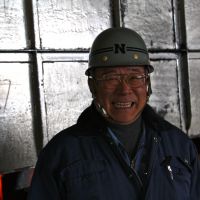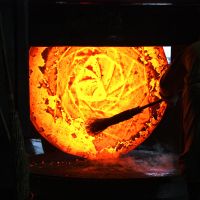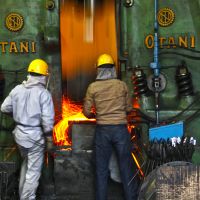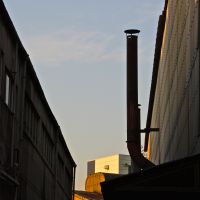In his "Meditation XVII," the English Metaphysical poet John Donne wrote in 1623 that "no man is an island, entire of itself." Well, yes — but some islands are entirely more manly than others.
Take Showajima (Showa Island) in Tokyo's Ota Ward, for example. Zoned exclusively for heavy industry, it has no shops, dwellings, schools or restaurants, and unlike the backstreets I usually frequent for this column, access requires contacts and appointments.
The Hamamatsucho-to-Haneda Tokyo Monorail bifurcates Showajima into eastern and western halves. At the manmade isle's eponymous station, I leave by the East Exit and proceed between a chain-link fence on one side and sheds that bump and grind with activity on the other.
It's a blisteringly cold day with the sun backlighting plumes of steam from factories and slicing through the corrugated plastic roofs of loading bays. The exsanguinated landscape, like a zombie movie set, features only the occasional male laborer in overalls.
At Maruzen Machine Works, I climb stairs to the toasty headquarters of the company's president Yoshiyuki Saito, 62, and his 88-year-old father Zengoro, founder of Maruzen. While Yoshiyuki fields a call, his mother Teruko — the first female I've spied on Showajima — serves me a lovely cup of green tea. When Yoshiyuki's ready, he tosses me a hard hat and gloves, and we descend to the factory floor.
The workspaces are cave-dark and the floor's slick with oil. Fat curls of metal shavings writhe gleaming from "cribs," the byproducts of a single-point lathe used for cutting threads on large screws. Maruzen employees create all kinds of fasteners, as well as precision parts for JR trains and carriages. "There are times," Yoshiyuki admits, "when we get orders for things but have no idea what they're for or how they'll be used. We simply make them."
I'm impressed by a forge-worker at Maruzen who sinks holes in steel ingots with a drop hammer. This gives Yoshiyuki an idea. We pile into his car and speed off to Showajima's west side, home of Miyachi Iron Works, in business for 94 years. I learn that Maruzen and Miyachi often collaborate on special orders; both companies pride themselves on making what no others can.
"It's the only way we survive," says Miyachi's sales director, Kuniaki Tomita, 65. "About 75 percent of all the iron works on Showajima have vanished, the work outsourced to China, Vietnam and India. We manage to hang on by making small quantities of high-quality products."
As we chat, my second cup of green tea grows concentric ripples and the Miyachi offices shake. Earthquake? T-Rex? Both Tomita and Yoshiyuki laugh. "That's the ironworks," Yoshiyuki says.
Donning hard hats and white lab coats, we first visit Miyachi's die-cutting and machining area, and then head toward the main attraction, a four-ton Otani air-drop hammer that reduces semi-molten chunks of steel into blazing pancakes with three bone-crunching blows.
Tomita nudges me forward to get a better look. I don't feel entirely safe in my flimsy lab coat and cockeyed helmet, but I comply all the same. Up close, the hammer literally jolts me off my feet, and the sound cannons in my ears. I take lots of blurry photos before escaping.
I ask Tomita whether women sign up for this work. "We had one once," he says, "but she ran away. This is classic 3k work," he continues, meaning kitanai, kiken and kitsui (dirty, dangerous and demeaning). "Once young men get trained, though, they usually stay." We wander through a forging area loomed over by a slightly less fearful two-ton hammer. Here, workers swing long tongs gripping chunks of metal around us in a hot ballet where one slip could be the final curtain.
Next, we pass stockpiles of what is called "round bar," including one of pure copper the color of fresh-sliced cantaloupe. Last, Tomita shows us Miyachi's waterjet cutter, which looks like an innocuous nozzle poised over a water tank. Tomita switches the machine on, and the water appears churned by piranhas. Now the little warning sign on the machine that portrays the jet lopping off a hand makes sense. Tomita explains that water combined with abrasive sand blasts out at up to 900 meters per second, and makes laser-like cuts through even thick cylinders of steel.
Handing back my safety gear, I thank Tomita and third-generation owner Takashi Miyachi, 65, for the great tour. Back at the peaceful surrounds of Maruzen, Yoshiyuki darts upstairs to work, but Zengoro comes down to accompany me around the 'hood.
I tell him I'd like to check out Nishimaki Iron Works around the corner. "I know those guys," he says. Zengoro, I soon learn, knows, and is known by, everyone on Showajima. The fifth son of 13 siblings — "or maybe it was only 12, 'cos I never really knew them all, and some went to live with aunts," he says — Zengoro started work after graduating from elementary school in Karuizawa, Nagano Prefecture. "It was either that or join the army, 'cos we couldn't afford middle school," he says. "So I came to Tokyo to make screws."
Learning his trade well, Zengoro opened shop in Tokyo's Chuo Ward in 1956, along with Teruko, to whom he was already married, and sibling # 9. By the 1960s, though, housing developments were squeezing out factories such as his. "They claimed we were noisy, dirty and troublesome," Zengoro recalls. "So I organized a metalworkers union to help secure land on Showajima."
By the 1970s, Showajima, along with Jonanjima and Keihinjima — two other manmade islands in Ota Ward — had been zoned exclusively for industry, and Zengoro moved his factory here.
At Nishimaki Iron Works, he introduces me to Yoshinori Nishimaki, 60, whose firm specializes in open-die forging — meaning hot forging on an unenclosed surface. I'm in luck because they are just about to "upset" (metalworkspeak for "increase the diameter and structural integrity of") two one-ton pieces of steel, using their 1,000-ton forging press.
Then they plan to drive holes through the discs. How will you do that, I ask. "With an explosion," Nishimaki says, his eyes glittering.
Sounds cool, I say. And dangerous, I think, sipping green tea # 3, then wriggling into yet another lab coat and plonking on a hard hat.
We head outside, where Nishimaki's furnaces reveal that the initial upsetting is already done on the two massive metal hunks. A manipulator truck gently bites one of the one-ton, 1,300e_SDgrC discs of steel and whips it from the furnace to the 1,000-ton press, where it gets flattened bit by bit like a flaming slab of pie dough. At first, the steel "screams" each time the press compromises its shape. Upsetting indeed. As it rotates, one worker uses a straw broom to sweep cooling scale from the metal. He then leaps away while the manipulator stands the disc on its side and rolls it as the press operator rounds off the rapidly cooling form. It begins to look like a giant pulsating rose.
After several trips back and forth to the furnace to keep the piece malleable, its diameter reaches more than 1.3 meters. Then, as I'm snapping pictures from close range as two guys caliper the disc's center, Nishimaki suddenly hauls me away by my lab coat, shouting something. In almost one motion, a worker sprinkles a handful of coal in the center of the disc just as the manipulator places a so-called punch plug on top momentarily before the press comes down. All hell breaks lose — sparks, flames and a whoosh of explosion — but the result is one kick-ass donut.
Thanking Nishimaki for the fiery show, Zengoro and I head back to his office. I ask whether we can stop in first at Tatsumi, a food and wine distribution company I've spotted. "Sure," says Zengoro, racing up three flights of stairs to the head offices of Tatsumi CEO Kazuhiro Sugita. Sugita, 57, greets Zengoro like a family member, and has someone bring us refreshments. I'm worried it will be green tea # 4, but instead it is the richest coffee I've tasted in years. "We have our own barista," says Sugita.
Tatsumi, Sugita explains, supplies 3,500 of Tokyo's restaurants with wines and delicacies from Italy and France. On the proviso I promise to print that Tatsumi accepts no individual sales whatsoever, I am allowed to peek at Tatsumi's wine cellars and coolers replete with hams, olives and cheeses. They're simply heavenly — but strictly off-limits.
I hug Zengoro goodbye, then walk to the island's west side, where the emergency evacuation area is getting a face-lift from Makoto Aoki, a staffer with park-design firm Green Shelter. "You'll be able to see the sunset from here," Aoki says, and sure enough, as we speak, our star begins to blaze as bright as all the day's forgings in one.travel






